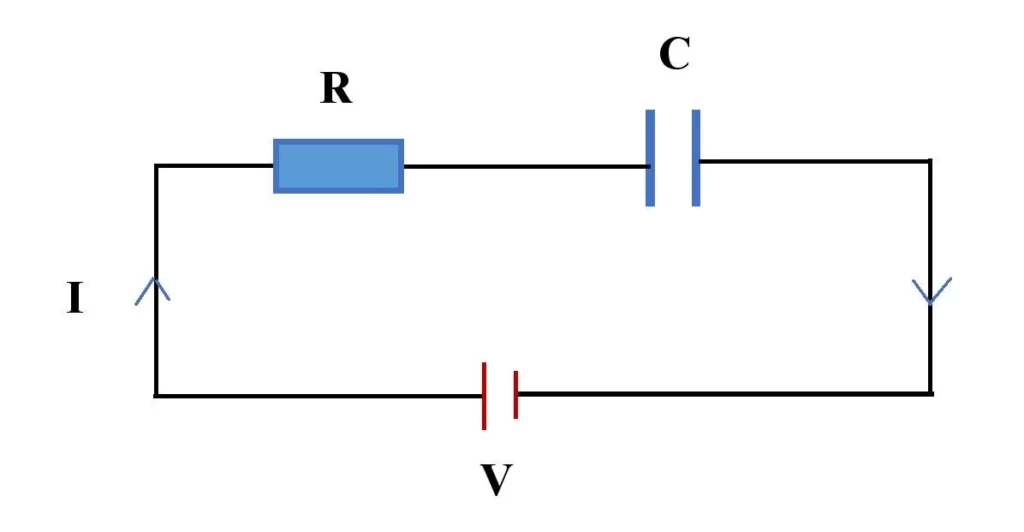A Capacitor is an important component in an electrical circuit. We have discussed different types of capacitors in other articles. Like other components (resistors, inductors), a capacitor also offers opposition to the current flow (Direct current only) through it. That means it generates impedance. Ohm’s law tells us that an impedance causes a voltage drop. Now, the question is, “Is there any voltage drop across a capacitor?” The answer is, “Yes”. In this article, I’m going to explain the formula of voltage drop across a capacitor in different situations. Let’s see how to calculate the voltage across a capacitor!
Read also: Voltage drop across inductor in AC circuit and Voltage drop across resistors
Why is there a voltage drop across a capacitor?

A capacitor is just a neutral conductor in absence of an external voltage source (before charging). But when an external voltage is applied across a capacitor, it begins to store electric charges inside it. Now, the voltage across a capacitor is directly proportional to the electric charge on it. The voltage across a capacitor changes due to a change in charge on it. So, during the charging of a capacitor, the voltage across it increases. When the capacitor is completely charged, the voltage across the capacitor becomes constant. Now, if we remove the external battery, the discharging of the capacitor begins. During the discharging of the capacitor, the voltage across it decreases and after a certain time, its voltage falls to zero.
Formula for voltage drop across a capacitor
Here I’m going to write all formulae of voltage drop across a capacitor in various stages like
- When the capacitor isn’t charged.
- During the charging of the capacitor.
- When the capacitor is fully charged.
- During discharging of the capacitor.
Read the following for these.
Voltage across an uncharged capacitor
The voltage drop across an uncharged capacitor is zero. Because, for an uncharged capacitor, Q=0 and hence, the voltage V=0.
Voltage across a capacitor during charging
During charging an AC capacitor of capacitance C with a series resistor R, the equation for the voltage across a charging capacitor at any time t is,
V(t) = Vs (1 – e-t/τ)……..(1)
Here τ = RC is the time constant in the series RC circuit and Vs is the maximum voltage of the external battery.
Voltage drop across a completely charged capacitor
After a long time of charging, the capacitor reaches the saturation condition. At this condition the voltage drop across it becomes maximum. The maximum voltage across a capacitor is Vs. But practically, the voltage across the capacitor cannot be as much as the maximum voltage of the battery. It should be a possible voltage V0. If Q is the maximum charge on the capacitor, then the formula for maximum voltage across the capacitor is \small {\color{Blue} V_{0} = \frac{Q}{C}}…….(2)
Then we get Q = CV0. This is a popular formula for the voltage across a capacitor.
Voltage across capacitor during discharging
If the external battery is removed, the capacitor switches to discharging mode and the voltage drop across the capacitor starts to decrease. The voltage across the discharging capacitor becomes,
V(t) = V0 e-t/τ………(3)
τ = RC is the time constant.
How to find voltage across capacitor?
The above equations are useful for the finding of voltage across a capacitor. There are different formulae for different situations. We need to use a proper formula to find the voltage across a capacitor as per our requirements.
- Step-1: First identify the situation – whether the capacitor is charging or discharging or at saturation condition.
- Step-2: Use the proper formula or equation according to the condition.
- Step-3: Put the values of required quantities like R, C, time constant, voltage of battery and charge (Q), etc. in that equation.
- Step-4: Calculate the value of the voltage from the equation.
Examples
1. A battery of AC peak voltage 10 volt is connected across a circuit consisting of a resistor of 100 ohm and an AC capacitor of 0.01 farad in series. If the capacitor is uncharged initially then find the voltage across the capacitor after 2 second.
Answer: In this case, the ac capacitor is in charging mode. So, the voltage drop across the capacitor is increasing with time.
The time constant, τ = RC = 1, the maximum voltage of battery, Vs = 10 volt and the time, t = 2 second.
Now, using the equation for the charging capacitor, V(t) = Vs (1 – e-t/τ), we get the voltage across the capacitor after 2 seconds, V = 8.65 volt.
This is all from this article on the voltage across capacitor formula. If you have any doubts on this topic you can ask me in the comment section.
Thank you!
Related posts:
- Voltage across an Inductor in AC circuit
- Formula for capacitance of different types of capacitor
- Parallel plate capacitor with dielectric
- Energy stored in a capacitor
- Voltage drop across Resistors in Series and Parallel circuits
- Surface charge density of Capacitor
Comments are closed.